Journal of Southern Medical University ›› 2024, Vol. 44 ›› Issue (9): 1653-1661.doi: 10.12122/j.issn.1673-4254.2024.09.04
Previous Articles Next Articles
Xiaohua CHEN1( ), Hui LU1, Ziliang WANG1, Lian WANG1, Yongsheng XIA1, Zhijun GENG2,4, Xiaofeng ZHANG2,4, Xue SONG2,4, Yueyue WANG3,4, Jing LI3,4, Jianguo HU3,4, Lugen ZUO1,4(
), Hui LU1, Ziliang WANG1, Lian WANG1, Yongsheng XIA1, Zhijun GENG2,4, Xiaofeng ZHANG2,4, Xue SONG2,4, Yueyue WANG3,4, Jing LI3,4, Jianguo HU3,4, Lugen ZUO1,4( )
)
Received:2024-04-22
Online:2024-09-20
Published:2024-09-30
Contact:
Lugen ZUO
E-mail:chenxiaohua9116@163.com;zuolugen@126.com
Xiaohua CHEN, Hui LU, Ziliang WANG, Lian WANG, Yongsheng XIA, Zhijun GENG, Xiaofeng ZHANG, Xue SONG, Yueyue WANG, Jing LI, Jianguo HU, Lugen ZUO. Role of Abelson interactor 2 in progression and prognosis of gastric cancer and its regulatory mechanisms[J]. Journal of Southern Medical University, 2024, 44(9): 1653-1661.
Add to citation manager EndNote|Ris|BibTeX
URL: https://www.j-smu.com/EN/10.12122/j.issn.1673-4254.2024.09.04
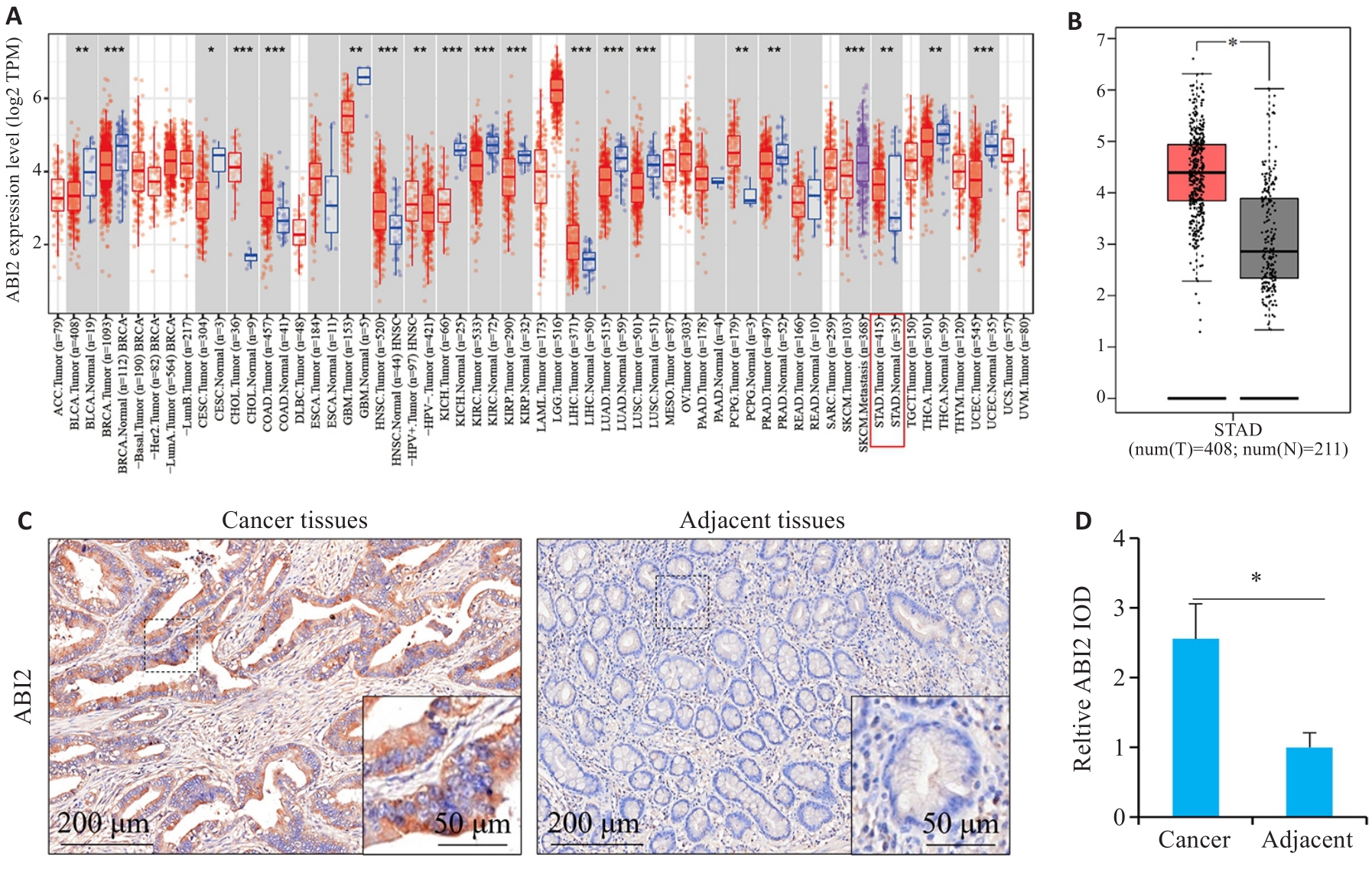
Fig.1 ABI2 is highly expressed in gastric cancer. A: Pan-cancer expression analysis. B: Expression of ABI2 in gastric and adjacent tissues. C, D: Immunohistochemical staining of ABI2 in gastric and adjacent tissues. *P<0.05, **P<0.01, ***P<0.001.
| Factors | n | ABI2 expression (n, %) | χ2 | Ρ | ||
|---|---|---|---|---|---|---|
| Low (n=60) | High (n=60) | |||||
| Gender | Male | 95 | 47 (49.47%) | 48 (50.53%) | 0.051 | 0.822 |
| Female | 25 | 13 (52.00%) | 12 (48.00%) | |||
| Age (year) | <60 | 49 | 27 (55.10%) | 22 (44.90%) | 0.862 | 0.353 |
| ≥60 | 71 | 33 (46.48%) | 38 (53.52%) | |||
| CEA (μg/L) | <5 | 57 | 35 (61.40%) | 22 (38.60%) | 5.647 | 0.017 |
| ≥5 | 63 | 25 (39.68%) | 38 (60.32%) | |||
| CA19-9 (kU/L) | <37 | 67 | 44 (65.67%) | 23 (34.33%) | 14.903 | <0.001 |
| ≥37 | 53 | 16 (30.19%) | 37 (69.81%) | |||
| Tumor size (cm) | <5 | 64 | 33 (51.56%) | 31 (48.44%) | 0.134 | 0.714 |
| ≥5 | 56 | 27 (48.21%) | 29 (51.79%) | |||
| Cancer cell type | Adenocarcinoma | 89 | 46 (51.69%) | 43 (48.31%) | 0.391 | 0.532 |
| Other | 31 | 14 (45.16%) | 17 (54.84%) | |||
| Pathological grading | G1-G2 | 66 | 41 (62.12%) | 25 (37.88%) | 8.620 | 0.003 |
| G3-G4 | 54 | 19 (35.19%) | 35 (64.81%) | |||
| T stage | T1-T2 | 51 | 33 (64.71%) | 18 (35.29%) | 7.673 | 0.006 |
| T3-T4 | 69 | 27 (39.13%) | 42 (60.87%) | |||
| N stage | N0-N1 | 60 | 36 (60.00%) | 24 (40.00%) | 4.800 | 0.028 |
| N2-N3 | 60 | 24 (40.00%) | 36 (60.00%) | |||
Tab.1 Correlation of ABI2 expression level with clinicopathological parameters of gastric cancer patients
| Factors | n | ABI2 expression (n, %) | χ2 | Ρ | ||
|---|---|---|---|---|---|---|
| Low (n=60) | High (n=60) | |||||
| Gender | Male | 95 | 47 (49.47%) | 48 (50.53%) | 0.051 | 0.822 |
| Female | 25 | 13 (52.00%) | 12 (48.00%) | |||
| Age (year) | <60 | 49 | 27 (55.10%) | 22 (44.90%) | 0.862 | 0.353 |
| ≥60 | 71 | 33 (46.48%) | 38 (53.52%) | |||
| CEA (μg/L) | <5 | 57 | 35 (61.40%) | 22 (38.60%) | 5.647 | 0.017 |
| ≥5 | 63 | 25 (39.68%) | 38 (60.32%) | |||
| CA19-9 (kU/L) | <37 | 67 | 44 (65.67%) | 23 (34.33%) | 14.903 | <0.001 |
| ≥37 | 53 | 16 (30.19%) | 37 (69.81%) | |||
| Tumor size (cm) | <5 | 64 | 33 (51.56%) | 31 (48.44%) | 0.134 | 0.714 |
| ≥5 | 56 | 27 (48.21%) | 29 (51.79%) | |||
| Cancer cell type | Adenocarcinoma | 89 | 46 (51.69%) | 43 (48.31%) | 0.391 | 0.532 |
| Other | 31 | 14 (45.16%) | 17 (54.84%) | |||
| Pathological grading | G1-G2 | 66 | 41 (62.12%) | 25 (37.88%) | 8.620 | 0.003 |
| G3-G4 | 54 | 19 (35.19%) | 35 (64.81%) | |||
| T stage | T1-T2 | 51 | 33 (64.71%) | 18 (35.29%) | 7.673 | 0.006 |
| T3-T4 | 69 | 27 (39.13%) | 42 (60.87%) | |||
| N stage | N0-N1 | 60 | 36 (60.00%) | 24 (40.00%) | 4.800 | 0.028 |
| N2-N3 | 60 | 24 (40.00%) | 36 (60.00%) | |||
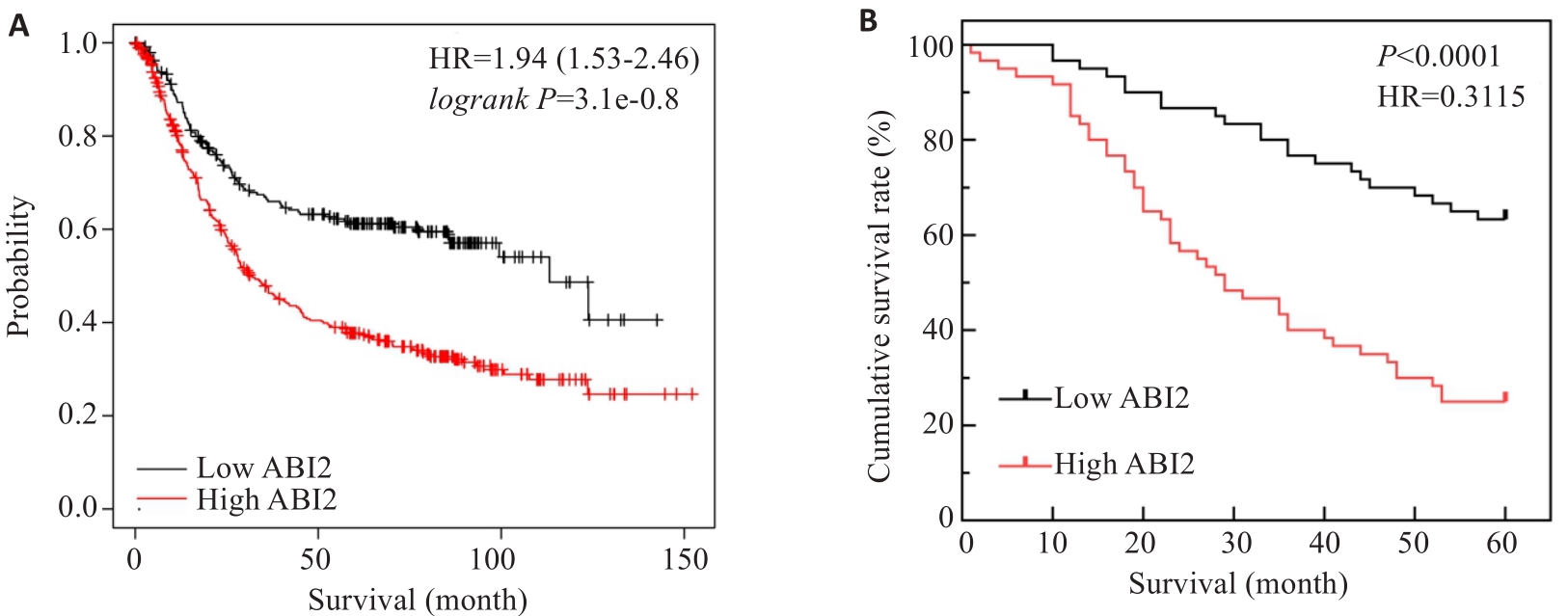
Fig.3 ABI2 expression level in gastric cancer tissues affects prognosis of the patients. A: ABI2 expression level affects overall survival of gastric cancer patients. B: Kaplan-Meier survival analysis of 5-year survival rate of the patients after radical gastrectomy.
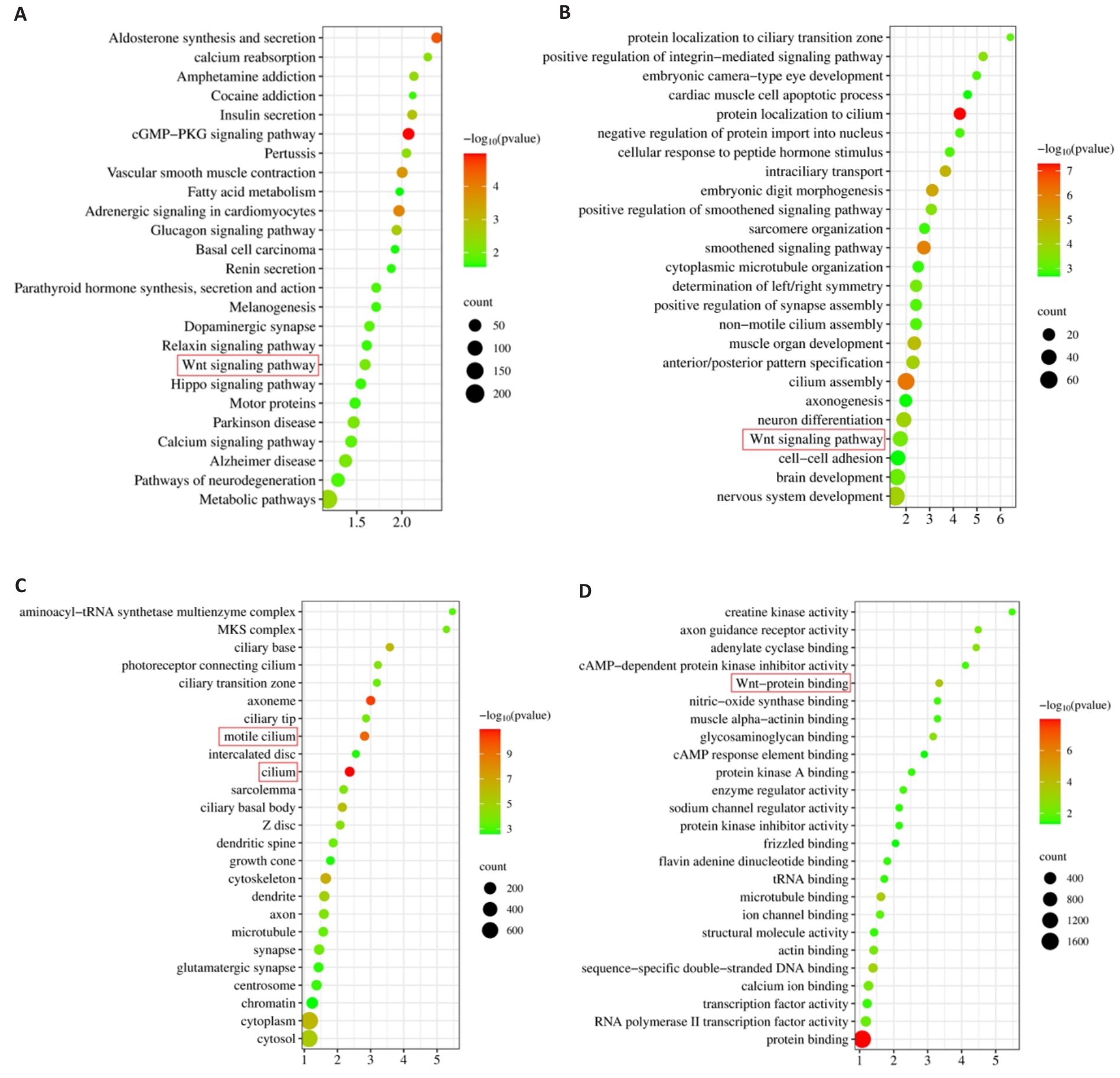
Fig.5 Results of KEGG and GO enrichment analysis. A: KEGG enrichment analysis. B-D: Biological processes, cellular component and molecular function in GO enrichment analysis.
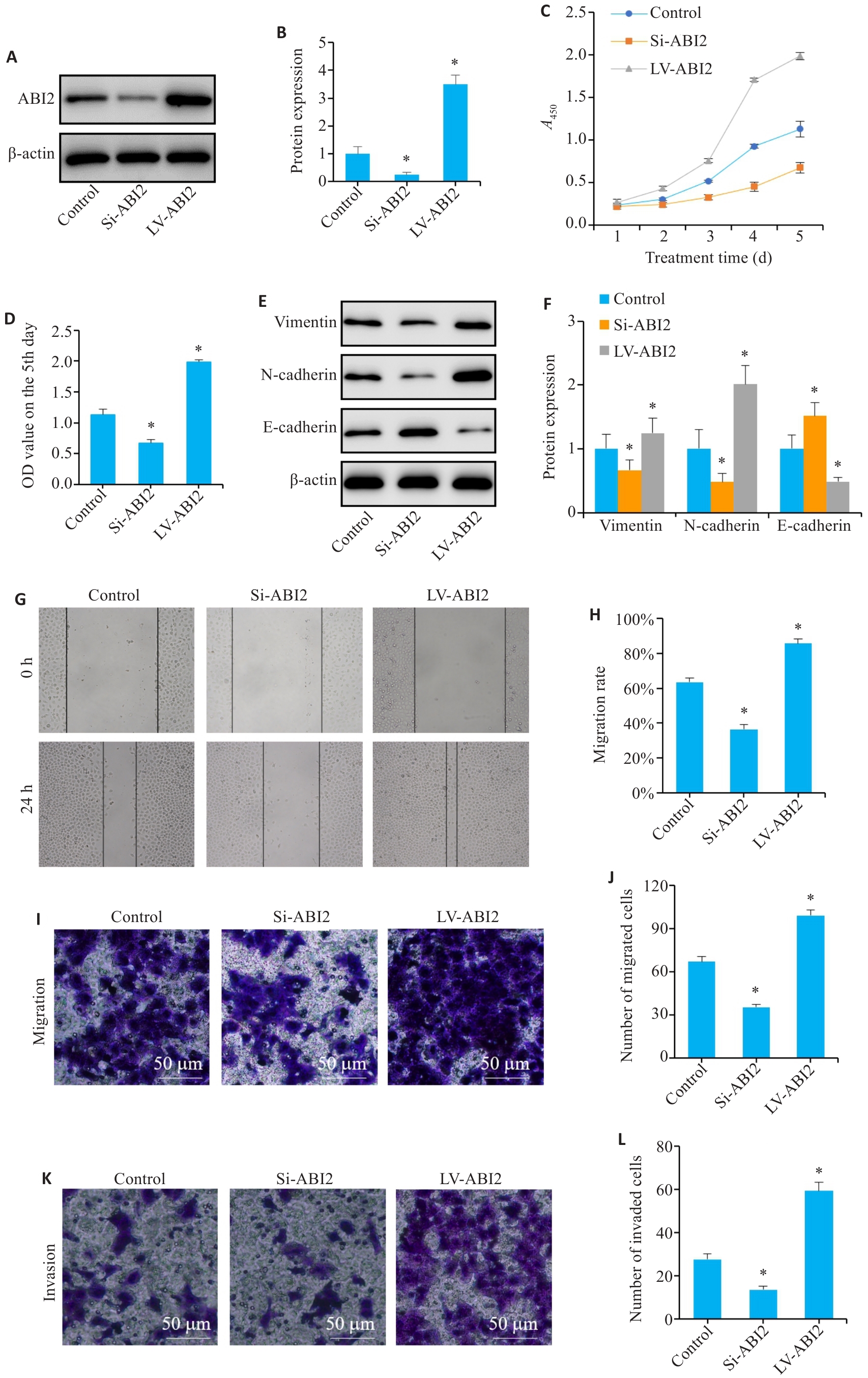
Fig.6 ABI2 overexpression promotes proliferation, migration, invasion, and epithelial-mesenchymal transition (EMT) of gastric cancer cells in vitro. A, B: Lentiviral transfection efficiency. C, D: Results of CCK-8 assay (presented as A values) from day 1 to day 5. E, F: Expression of EMT markers in MGC803 cells. G, H: Wound-healing assay of the cells. I-L: Migration and invasion of MGC803 cells. Si: siRNA; LV: overexpression. *P<0.05 vs Control (n=3).
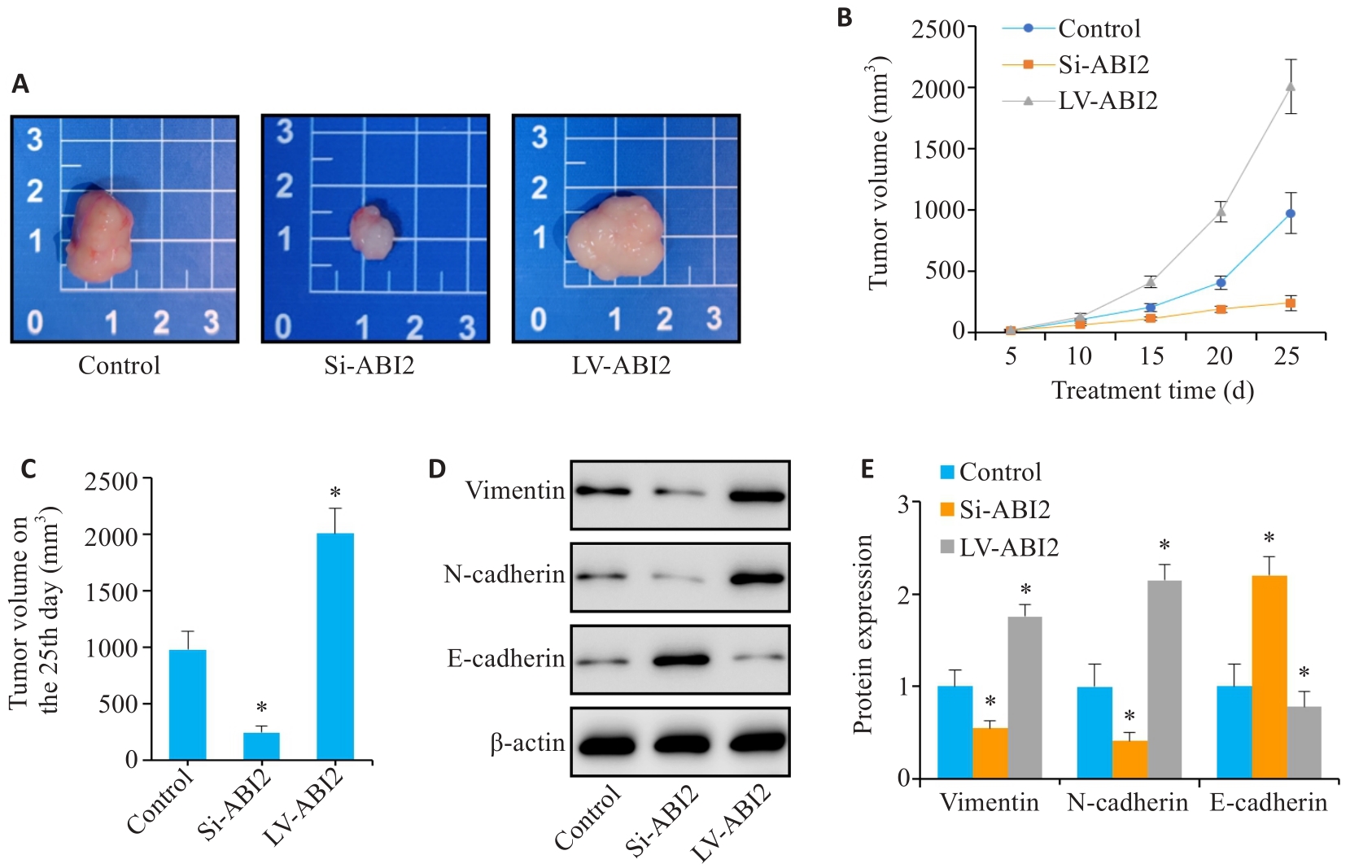
Fig.7 ABI2 overexpression promotes proliferation and epithelial-mesenchymal transition of gastric cancer cells in nude mice. A: Representative image of the transplanted tumors. B, C: Transplanted tumor volume from day 5 to day 25. D, E: Expression of EMT markers in the transplanted tumor. *P<0.05 vs Control (n=3).

Fig.8 The effect of ABI2 on malignant biological behaviors of gastric cancer cells is related to the Wnt signaling pathway. A, B: Expression of Wnt2 and β-catenin in MGC803 cells. C, D: Expression of Wnt2 and β-catenin in the transplanted tumors. *P<0.05 vs Control (n=3).
| 1 | Smyth EC, Nilsson M, Grabsch HI, et al. Gastric cancer[J]. Lancet, 2020, 396(10251): 635-48. |
| 2 | 郑荣寿, 张思维, 孙可欣, 等. 2016年中国恶性肿瘤流行情况分析[J]. 中华肿瘤杂志, 2023, 45(3): 212-20. DOI: 10.3760/cma.j.cn112152-20220922-00647 |
| 3 | Thrift AP, El-Serag HB. Burden of gastric cancer[J]. Clin Gastroenterol Hepatol, 2020, 18(3): 534-42. |
| 4 | Chia NY, Tan P. Molecular classification of gastric cancer[J]. Ann Oncol, 2016, 27(5): 763-9. |
| 5 | Jiang PX, Tang SN, Hudgins H, et al. The Abl/Abi signaling links WAVE regulatory complex to Cbl E3 ubiquitin ligase and is essential for breast cancer cell metastasis[J]. Neoplasia, 2022, 32: 100819. |
| 6 | Ichigotani Y, Fujii K, Hamaguchi M, et al. In search of a function for the E3B1/Abi2/Argbp1/NESH family (Review)[J]. Int J Mol Med, 2002, 9(6): 591-5. |
| 7 | Zipfel PA, Bunnell SC, Witherow DS, et al. Role for the Abi/wave protein complex in T cell receptor-mediated proliferation and cytoskeletal remodeling[J]. Curr Biol, 2006, 16(1): 35-46. |
| 8 | Courtney KD, Grove M, Vandongen H, et al. Localization and phosphorylation of Abl-interactor proteins, Abi-1 and Abi-2, in the developing nervous system[J]. Mol Cell Neurosci, 2000, 16(3): 244-57. |
| 9 | Hirao N, Sato S, Gotoh T, et al. NESH (Abi-3) is present in the Abi/WAVE complex but does not promote c-Abl-mediated phosphorylation[J]. FEBS Lett, 2006, 580(27): 6464-70. |
| 10 | Li YZ, Clough N, Sun XL, et al. Bcr-Abl induces abnormal cytoskeleton remodeling, beta1 integrin clustering and increased cell adhesion to fibronectin through the Abl interactor 1 pathway[J]. J Cell Sci, 2007, 120(Pt 8): 1436-46. |
| 11 | Ryu JR, Echarri A, Li R, et al. Regulation of cell-cell adhesion by Abi/Diaphanous complexes[J]. Mol Cell Biol, 2009, 29(7): 1735-48. |
| 12 | Stradal T, Courtney KD, Rottner K, et al. The Abl interactor proteins localize to sites of actin polymerization at the tips of lamellipodia and filopodia[J]. Curr Biol, 2001, 11(11): 891-5. |
| 13 | Jensen CC, Clements AN, Liou H, et al. PIM1 phosphorylates ABI2 to enhance actin dynamics and promote tumor invasion[J]. J Cell Biol, 2023, 222(6): e202208136. |
| 14 | Chen JD, Li HZ, Zhang B, et al. ABI2-mediated MEOX2/KLF4-NANOG axis promotes liver cancer stem cell and drives tumour recurrence[J]. Liver Int, 2022, 42(11): 2562-76. |
| 15 | Guan WL, He Y, Xu RH. Gastric cancer treatment: recent progress and future perspectives[J]. J Hematol Oncol, 2023, 16(1): 57. |
| 16 | Wang B, Mysliwiec T, Krainc D, et al. Identification of ArgBP1, an Arg protein tyrosine kinase binding protein that is the human homologue of a CNS-specific Xenopus gene[J]. Oncogene, 1996, 12(9): 1921-9. |
| 17 | Dai Z, Pendergast AM. Abi-2, a novel SH3-containing protein interacts with the c-Abl tyrosine kinase and modulates c-Abl transforming activity[J]. Genes Dev, 1995, 9(21): 2569-82. |
| 18 | Grove M, Demyanenko G, Echarri A, et al. ABI2-deficient mice exhibit defective cell migration, aberrant dendritic spine morphogenesis, and deficits in learning and memory[J]. Mol Cell Biol, 2004, 24(24): 10905-22. |
| 19 | Chen ZC, Borek D, Padrick SB, et al. Structure and control of the actin regulatory WAVE complex[J]. Nature, 2010, 468(7323): 533-8. |
| 20 | Shami Shah A, Batrouni AG, Kim D, et al. PLEKHA4/kramer attenuates dishevelled ubiquitination to modulate Wnt and planar cell polarity signaling[J]. Cell Rep, 2019, 27(7): 2157-70. e8. |
| 21 | Nusse R, Clevers H. Wnt/β-catenin signaling, disease, and emerging therapeutic modalities[J]. Cell, 2017, 169(6): 985-99. |
| 22 | Zhao H, Ming TQ, Tang S, et al. Wnt signaling in colorectal cancer: pathogenic role and therapeutic target[J]. Mol Cancer, 2022, 21(1): 144. |
| 23 | Li HJ, Ke FY, Lin CC, et al. ENO1 promotes lung cancer metastasis via HGFR and WNT signaling-driven epithelial-to-mesenchymal transition[J]. Cancer Res, 2021, 81(15): 4094-109. |
| 24 | Hiremath IS, Goel A, Warrier S, et al. The multidimensional role of the Wnt/β‑catenin signaling pathway in human malignancies[J]. J Cell Physiol, 2022, 237(1): 199-238. |
| 25 | Rim EY, Clevers H, Nusse R. The Wnt pathway: from signaling mechanisms to synthetic modulators[J]. Annu Rev Biochem, 2022, 91: 571-98. |
| 26 | Albrecht LV, Tejeda-Muñoz N, de Robertis EM. Cell biology of canonical Wnt signaling[J]. Annu Rev Cell Dev Biol, 2021, 37: 369-89. |
| 27 | Cheng XX, Wang ZC, Chen XY, et al. Frequent loss of membranous E-cadherin in gastric cancers: a cross-talk with Wnt in determining the fate of beta-catenin[J]. Clin Exp Metastasis, 2005, 22(1): 85-93. |
| 28 | Guo Q, Xu J, Huang Z, et al. ADMA mediates gastric cancer cell migration and invasion via Wnt/β‑catenin signaling pathway[J]. Clin Transl Oncol, 2021, 23(2): 325-34. |
| 29 | Wang J, Cai H, Liu QL, et al. Cinobufacini inhibits colon cancer invasion and metastasis via suppressing Wnt/β‑catenin signaling pathway and EMT[J]. Am J Chin Med, 2020, 48(3): 703-18. |
| 30 | Park JK, Song JH, He TC, et al. Overexpression of Wnt-2 in colorectal cancers[J]. Neoplasma, 2009, 56(2): 119-23. |
| 31 | Shi YH, He B, Kuchenbecker KM, et al. Inhibition of Wnt-2 and galectin-3 synergistically destabilizes beta-catenin and induces apoptosis in human colorectal cancer cells[J]. Int J Cancer, 2007, 121(6): 1175-81. |
| 32 | Vider BZ, Zimber A, Chastre E, et al. Evidence for the involvement of the Wnt 2 gene in human colorectal cancer[J]. Oncogene, 1996, 12(1): 153-8. |
| 33 | Katoh M. WNT2 and human gastrointestinal cancer (review)[J]. Int J Mol Med, 2003, 12(5): 811-6. |
| 34 | Kramer N, Schmöllerl J, Unger C, et al. Autocrine WNT2 signaling in fibroblasts promotes colorectal cancer progression[J]. Oncogene, 2017, 36(39): 5460-72. |
| 35 | Lei L, Wang Y, Li ZH, et al. PHLDA3 promotes lung adenocarcinoma cell proliferation and invasion via activation of the Wnt signaling pathway[J]. Lab Invest, 2021, 101(9): 1130-41. |
| 36 | Pu P, Zhang Z, Kang C, et al. Downregulation of Wnt2 and beta-catenin by siRNA suppresses malignant glioma cell growth[J]. Cancer Gene Ther, 2009, 16(4): 351-61. |
| [1] | Xinyuan CHEN, Chengting WU, Ruidi LI, Xueqin PAN, Yaodan ZHANG, Junyu TAO, Caizhi LIN. Shuangshu Decoction inhibits growth of gastric cancer cell xenografts by promoting cell ferroptosis via the P53/SLC7A11/GPX4 axis [J]. Journal of Southern Medical University, 2025, 45(7): 1363-1371. |
| [2] | Ting XIE, Yunyun WANG, Ting GUO, Chunhua YUAN. The peptide toxin components and nucleotide metabolites in Macrothele raveni venom synergistically inhibit cancer cell proliferation by activating the pro-apoptotic pathways [J]. Journal of Southern Medical University, 2025, 45(7): 1460-1470. |
| [3] | Jinlong PANG, Xinli ZHAO, Zhen ZHANG, Haojie WANG, Xingqi ZHOU, Yumei YANG, Shanshan LI, Xiaoqiang CHANG, Feng LI, Xian LI. Overexpression of multimerin-2 promotes cutaneous melanoma cell invasion and migration and is associated with poor prognosis [J]. Journal of Southern Medical University, 2025, 45(7): 1479-1489. |
| [4] | Xiuying GONG, Shunfu HOU, Miaomiao ZHAO, Xiaona WANG, Zhihan ZHANG, Qinghua LIU, Chonggao YIN, Hongli LI. LncRNA SNHG15 promotes proliferation, migration and invasion of lung adenocarcinoma cells by regulating COX6B1 through sponge adsorption of miR-30b-3p [J]. Journal of Southern Medical University, 2025, 45(7): 1498-1505. |
| [5] | Xuan WU, Jiamin FANG, Weiwei HAN, Lin CHEN, Jing SUN, Qili JIN. High PRELID1 expression promotes epithelial-mesenchymal transition in gastric cancer cells and is associated with poor prognosis [J]. Journal of Southern Medical University, 2025, 45(7): 1535-1542. |
| [6] | Kang WANG, Haibin LI, Jing YU, Yuan MENG, Hongli ZHANG. High expression of ELFN1 is a prognostic biomarker and promotes proliferation and metastasis of colorectal cancer cells [J]. Journal of Southern Medical University, 2025, 45(7): 1543-1553. |
| [7] | Jiahao LI, Ruiting XIAN, Rong LI. Down-regulation of ACADM-mediated lipotoxicity inhibits invasion and metastasis of estrogen receptor-positive breast cancer cells [J]. Journal of Southern Medical University, 2025, 45(6): 1163-1173. |
| [8] | Xinrui HOU, Zhendong ZHANG, Mingyuan CAO, Yuxin DU, Xiaoping WANG. Salidroside inhibits proliferation of gastric cancer cells by regulating the miR-1343-3p-OGDHL/PDHB glucose metabolic axis [J]. Journal of Southern Medical University, 2025, 45(6): 1226-1239. |
| [9] | Yumei ZENG, Jike LI, Zhongxi HUANG, Yibo ZHOU. Villin-like protein VILL suppresses proliferation of nasopharyngeal carcinoma cells by interacting with LMO7 protein [J]. Journal of Southern Medical University, 2025, 45(5): 954-961. |
| [10] | Yaqing YUE, Zhaoxia MU, Xibo WANG, Yan LIU. Aurora-A overexpression promotes cervical cancer cell invasion and metastasis by activating the NF-κBp65/ARPC4 signaling axis [J]. Journal of Southern Medical University, 2025, 45(4): 837-843. |
| [11] | Yi ZHANG, Yu SHEN, Zhiqiang WAN, Song TAO, Yakui LIU, Shuanhu WANG. High expression of CDKN3 promotes migration and invasion of gastric cancer cells by regulating the p53/NF-κB signaling pathway and inhibiting cell apoptosis [J]. Journal of Southern Medical University, 2025, 45(4): 853-861. |
| [12] | Shunjie QING, Zhiyong SHEN. High expression of hexokinase 2 promotes proliferation, migration and invasion of colorectal cancer cells by activating the JAK/STAT pathway and regulating tumor immune microenvironment [J]. Journal of Southern Medical University, 2025, 45(3): 542-553. |
| [13] | Lu TAO, Zhuoli WEI, Yueyue WANG, Ping XIANG. CEACAM6 inhibits proliferation and migration of nasopharyngeal carcinoma cells by suppressing epithelial-mesenchymal transition [J]. Journal of Southern Medical University, 2025, 45(3): 566-576. |
| [14] | Qingqing HUANG, Wenjing ZHANG, Xiaofeng ZHANG, Lian WANG, Xue SONG, Zhijun GENG, Lugen ZUO, Yueyue WANG, Jing LI, Jianguo HU. High MYO1B expression promotes proliferation, migration and invasion of gastric cancer cells and is associated with poor patient prognosis [J]. Journal of Southern Medical University, 2025, 45(3): 622-631. |
| [15] | Huali LI, Ting SONG, Jiawen LIU, Yongbao LI, Zhaojing JIANG, Wen DOU, Linghong ZHOU. Prognosis-guided optimization of intensity-modulated radiation therapy plans for lung cancer [J]. Journal of Southern Medical University, 2025, 45(3): 643-649. |
| Viewed | ||||||
|
Full text |
|
|||||
|
Abstract |
|
|||||